 zachary harden
zachary harden
Keywords: honved |
Links: FOTW homepage | search | disclaimer and copyright | write us | mirrors

Last modified: 2023-06-03 by  zachary harden
zachary harden
Keywords: honved |
Links: FOTW homepage |
search |
disclaimer and copyright |
write us |
mirrors
See also:
Other sites:
HONVÉD means soldier this is patriotic word. The word
"katona" = soldier is neutral. The word
"honvéd" = soldier means "the soldier who save
our country". HON = homeland VÉD = save. The new Hungarian
Army in 1848 was the Magyar Honvédség. The name of the
Hungarian army: between 1867-1949 Magyar Honvédség, 1949-1989
Magyar Néphadsereg (Hungarian People's Army), 1989-now Magyar
Honvédség.
The Budapesti Honvéd was the football-club of the army
1949-1989. Now the name of the FC. is Kispest-Honvéd FC
István Molnár, 25 November 2000
"VÉD" actually means to guard. So, the term
more correctly means "Home Guard".
Georges Kovari, 27 November 2000
Antonio Martins asked: "Shouldn't the shade of red also
be lighter, like in the Hungarian national flag?"
The answer is no. This red is the "colour of the
International Labour Movement". In Hungarian this red is
"vörös", the red of the national flag is
"piros".
István Molnár, 4 December 2000

image by Željko Heimer, 5 November 2001
Flaggenbuch [neu92] regarding
to Hungary (pages 177 and 178): Commander-in-Chief of the
"Stormwache" (Generalkaptänsflagge der Stormwache) -
As merchant flag with white border with red and green wolf-teeth.
This one has size specification as 100 x 150 cm, with border
width 10 cm.
Željko Heimer, 5 November 2001
In fact it is spelt "Stromwache" on Flaggenbuch 1939, meaning "River Guard"
in German.
Miles Li, 05 March 2016
The word "Strom" means in this context as a river.
Source:
https://books.google.de/books/about/Donau_Marineure_und_die_k%c3%b6niglich_ungar.html?id=yGYAfAEACAAJ&redir_esc=y
In the Free State of Danzig there was also a Küsten- und Stromwache (Coast and
River Guard). The guard was a branch of the
Harbour Authority
(Correct spelling: Flagge des Auschusses für den Hafen und die Wasserwege von
Danzig)
I propose to publish also the Hungarian name of the authority.
There are the book: Haditengerészek és FolyamÖrÖk a Dunan 1870-1945 -
Donau-Marineure und die kÖniglich-ungarische Stromwache 1870-1945
Jens Pattke, 06 March 2016
The correct term for Stromwache (as organization) is "Folyamõrség" in
Hungarian. Folyamõr (or folyamõrÖk in plural) means member(s) of
this force. But the term in German title of the book was the official name, it
is "Magyar Királyi Folyamõrség" in Hungarian.
Zoltan Horvath, 06 March 2016
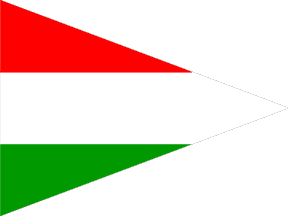
image by Željko Heimer, 6 November 2001
Adopted: 1919. Abandoned: 1944. The senior officer's pennant
is a tricolour trinagular pennant.
Željko Heimer
Flaggenbuch [neu92] regarding
to Hungary (pages 177 and 178): Senior Officer Afloat.
(Dienstaltersstander.) Triangular pennant horizontally divided in
RWV. 60x80 cm.
Željko Heimer, 5 November 2001

image by Željko Heimer, 6 November 2001
Adopted: 1919. Abandoned: 1944. The pennant is in shape of a
long tricolour triangle.
Željko Heimer
Flaggenbuch [neu92] regarding
to Hungary (pages 177 and 178): Masthead Pennant - Triangular
pennant of the national tricolour. 10 x 300 cm.
Željko Heimer, 5 November 2001
Flag of the Royal Hungarian Bocskay Istva'n 11th Haiduk
regiment (Debrecen), 1920:
"After the shock of World War I and the revolutions the
society had to face the consequences of the Trianon peace treaty
as well. The country that had lost the two thirds of its
territory and had become internationally isolated, grasped its
glorious past and turned to its symbols. The tendency may be
followed in connection with the National Army's and the Royal
Hungarian Army's system of emblems.
The troop flag, the basic symbol of the army, was formed
considering the traditions. The 1920 flag of the Bocskai István
hajdú regiment recalls the Home Guard flags of 1848, even if the
embroidered decoration made by patriotic women is unusual. With
the 1938 flag decree the spirit of 1848 was restored and Holy
Mary replaced on the flags, although tongues of flame were used
instead of triangles in the trimming, following the Hungarian
method of the l8th century. The claim of territorial revision was
suggested by the use of the medium coat of arms of Hungary only
however, this was quite obvious for those who were familiar with
heraldry."
Source: Sword and Wreath. Hungarian Military Symbols of the Last
Millennium. Exhibition Guide. Museum of Military History of
Hungary; Budapest
István Molnár, 5 June 2001
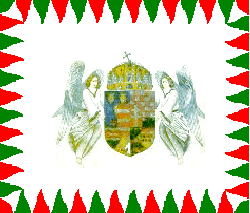
image by István Molnár, 24 June 2001
Description: "15. Infantry standard M 1938 - This
infantry standard was used in World War II. It was manufactured
following the pattern of honvéd flags, however, in place of the
trimming triangles (`teeth') there are tongues of flame, which
had been applied from the l8th century on. The coat of arms on
the flag is the Hungarian national arms used by the army between
the two World Wars". Reconstruction based on this picture at
<www.geocities.com/zaszlok/Muzeum>.
István Molnár, 24 June 2001
Here is photos of the Military
Unit Flag 1938 M type and its reverse side. See also photo of Hungarian military
flag (reverse side) and Regent Horthy.
István Molnár, 24 January 2002 and 1 February 2006
The historical war flag of Hungary is the white with red and
green wolf-teeth flags charged with the actual CoA and on the
other side with St. Mary. Between 1949-1989 the field of the flag
was red and the wolfteeth were white and green, and of course the
reverse side there was no St. Mary. You could saw on the flag the
"Kossuth-CoA" which is the CoA without crown.
István Molnár, 9 November 2000
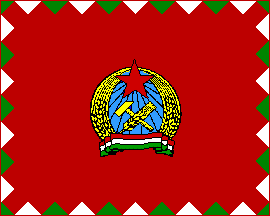
image by István Molnár, 3 December 2000
This image based on a TV program about the Institute and Museum
of the Military History. The coat of arms from Željko pages, but I
corrected the blue colours. On the description: light blue, like
the sky.
Those flags were used in 1949-1956.
István Molnár, 3 December 2000
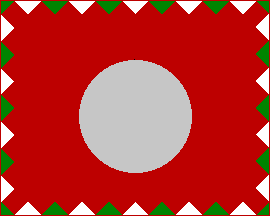
imagr by István Molnár, 21 March 2001
Today I was in the museum "House of Terror",
Budapest (see <www2.terrorhaza.hu>).
I found the flag of the 26th infantry regiment (Nagykanizsa) from
1956 with hole.
István Molnár, 21 March 2001
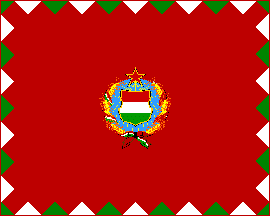
image by István Molnár, 3 December 2000
I located a photo of
Hungarian People's Republic-era military color at <www.bjkmf.hu>.
The text is in Hungarian. A bigger image (144 Kb) is at <www.bjkmf.hu/history/feg.jpg>.
David Fowler, 24 September 1999
This is a guess, but I think it goes about a kind of military
music school - or military orchestra or something. Anyway, it is
showing how Hungarians maintained their flag tradition in
communist times too.
Željko Heimer, 24 September 1999
I am Hungarian and can give information on the native language
sources, in this case about the red 1960's military flag fringed
in the national colours with the communist emblem in the middle,
off of a Hungarian language website. Instead of a music school
(probably mistaked the word Muszaki for music) it actually is a
technical school, and this particular flag was the adopted flag
of the 4th district weapons and military gas equipment plant
belonging to this technical/ordnance school. Also the red color
most likely signifies the communist era, and at that time all the
traditionally white war flags with the red/green fringe were
changed to red flags but maintained a nationalistic green and
white fringe
Mark Kasaroczky , 3 December 1999
This image based on a TV program about the Institut and Museum
of the Military History. The coat of arms from Željko pages, but I
corrected the blue colours. On the description: light blue, like
the sky.
Those flags were used in 1957-1989.
István Molnár, 3 December 2000
At EBay
there is "Rare Hungarian Army Flag - Soviet Era: Here is a
rare Hungarian army flag used during the Communist era. It
is double sided with the same image on a heavy cotton with
elaborate and carefully stitched embroidery.
Photos here and here.
Rob Raeside, 8 June 2002
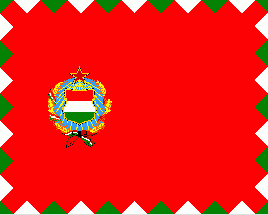
image by Klaus-Michael Schneider, 9 March 2009
It is a red flag with a bordure of alternating white and green
isosceles triangles. The coat of arms of the People’s
Republic of Hungary is shifted to the hoist. Source: [ped79a]; p.45
Klaus-Michael Schneider, 9 March 2009

image by Klaus-Michael Schneider, 9 March 2009
It is a red flag with green triangles in each
corner and a bordure of alternating white and green isosceles
triangles. The coat of arms of the People’s Republic of
Hungary is shifted to the hoist.
Source: [ped79a]; p.45
Klaus-Michael Schneider, 9 March 2009
When I googled some images about Hungarian military flags, I came across this
picture. It
was the Senior Commander's Pennant in pre-1990 period.
It was reported as Supreme Commander Pennant by Klaus-Michael in 2009, but I think this title is
misleading, because it was the former Senior Commander's Pennant.
Zoltan Horvath, 04 October 2014

image by Zeljko Heimer, 24 December 2018
I am finishing a book that stands on my desk for a long time, I have been reading it a paragraph or two at the time for ages. By the very end of the book I finally found something unexpected. Namely, Barraclough's 1965 edition of the "Flags of the World", on p. 279 mentions a Hungarian ensign that I can't remember seeing anywhere else - at least if I interpret the description correctly:
A crimson flag bearing the emblem at the top of the hoist, and beneath it three narrow horizontal stripes, red over white over green, is used by the River Guard.The "emblem" is, supposedly the 1957 "Kádar coat of arms" with the tricolour shield, Barraclough describes a few paragraphs above. Well, I am aware (from the above-mentioned page, certainly, quoting Pedersen 1979) that the river fleet used a design equal to the military colors (but maybe for the dimensions), and I believe that this is still practice today (with white ensigns), but it seems that in the late 1950s there was a special flag, I have not seen mentioned anywhere else. Or, is the Barraclough description only a bad interpretation of the Fleet Patrol Flag from Pedersen we show on the abovementioned page?
Flag of one organisaton of the Munkásőrség (1957-1989) ia at
<mek.oszk.hu>.
Munkásőrség (Magyarországon) was the paramilitary
Workers Militia/Guard.
István Molnár, 26 January 2006
Here is a photo of the
symbol of the Munkásőrség taken by me at the Hungarian
National Museum.
István Molnár, 20 February 2006
Here are photos of flags from the 20th century that I took during my visit at the Museum of the Hungarian Military History:
István Molnár, 17 March 2006